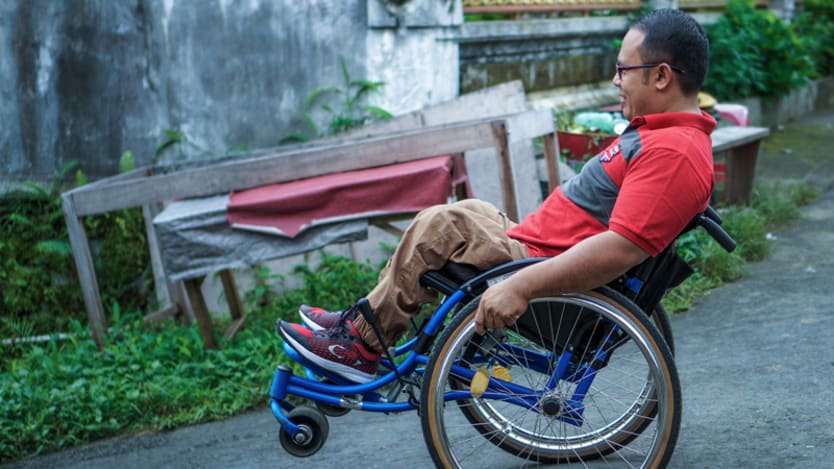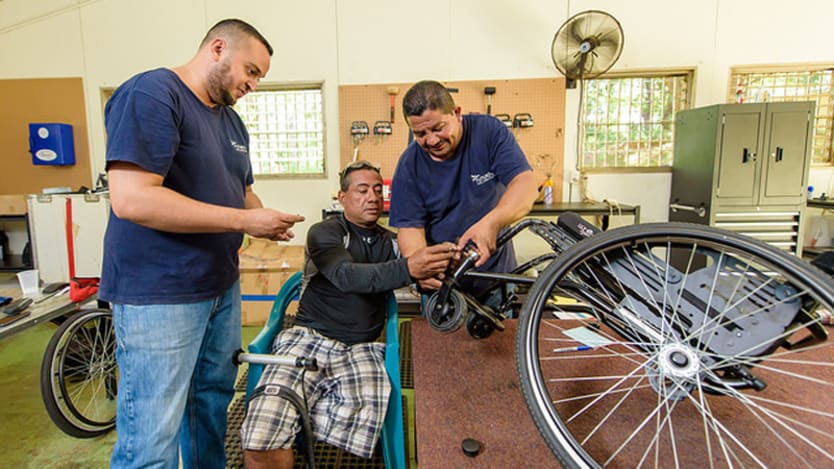
According to the World Health Organization, more than 1 billion people globally require assistive products such as wheelchairs, prosthetics, or hearing aids. And as humans live longer and populations grow, we can expect unprecedented growth in product demand. However, in many low- and middle-income countries only 5-15 percent of people who need such products have access to them.
People living with disabilities are often challenged to engage, economically and socially, with health services and potentially, to perform daily life tasks. The right device or technology, however, can enable those living with a disability to study, work, socialize, and to be in a relationship, if they choose, said Vic McKinney, a research fellow at the department of health and rehabilitation sciences at the University of Cape Town, South Africa.
For example, assistive products have been crucial in enabling McKinney — who was paralyzed from the shoulders down at the age of 19 following an accident — to pursue an academic career and live a full life.
“The difference an assistive product can make to somebody who’s disabled can be everything,” he said. “It provides a gateway to their life.”
Lack of access to assistive products
Disability is often associated with poverty, with each exacerbating the other, and that link is pronounced in LMICs, where assistive products are often not available and typically not covered by universal health systems. This forces people to live without the critical product, divert already limited income from other basic needs as out-of-pocket payments, or to rely on sporadic and unregulated donations.
Providing access to assistive products is often a low priority in LMIC governments’ already limited budgets, said Chapal Khasnabis, program manager at the Global Cooperation on Assistive Technology, part of the department of essential medicines and health products at WHO.
This is exacerbated by a misperception that the demand for assistive products is low, while in fact, most people benefit from them at some point in their lives. With the aging global population and a rise in noncommunicable diseases, it is estimated that more than 2 billion people will need at least one assistive product by 2030.
A failure by governments to provide assistive products is also bad economics, Khasnabis argued. With a suitable wheelchair, for example, many people with disabilities can be enabled to work. Without one, those with a disability can find themselves dependent on state benefits or pensions, and the care of relatives, whose ability to work is then also curtailed.
“The difference an assistive product can make to somebody who’s disabled can be everything. It provides a gateway to their life.”
— Vic McKinney, research fellow, division of disability studies, department of health and rehabilitation sciences, University of Cape TownThe challenges
The challenges of providing assistive products in developing countries are complex. The assistive product industry globally is dominated by manufacturers that design products for developed countries, often operating under a high-margin, low-volume model, Khasnabis said.
Why access to assistive products is limited in LMICs
1. Few LMICs cover or subsidize the cost of assistive products under national insurance schemes, making products prohibitively expensive for low-income earners.
2. LMICs often have not developed distribution, referral, and provision networks. This means getting products to the people who need them — who sometimes live in remote, rural areas — is slow and expensive.
3. The majority of assistive products are manufactured for sale in high-income countries, contributing to the low availability of affordable, quality products in LMICs.
4. A lack of awareness — both among users and practitioners — about the variety of products available and what new technologies can do is another challenge, said Mansoor Golra, project and information officer for Paraplegic Centre Peshawar in Pakistan.
5. Limited local availability of related services, such as technically trained professionals to customize assistive products and to teach people how to use them or conduct repairs, aggravates the problem.
6. A lack of physical infrastructures, such as rehabilitation centers staffed with assistive product experts or other service providers also limits people’s ability to access the right product, Golra added.
In countries where local production does exist, products are often low-quality, do not meet global standards, and are comparatively high cost. The relatively small market in any LMIC for a particular type of assistive product makes it difficult for in-country manufacturers to benefit from economies of scale, Khasnabis continued. For LMICs that import assistive products, limited financial resources and a small variety of available products mean buyers tend to procure from a single supplier with limited, often low-quality options.
Countries or organizations sourcing assistive products have historically received a container full of the same devices, regardless of need, noted Cara Thanassi, senior human rights advisor, USAID’s Center of Excellence on Democracy, Human Rights and Governance.
People’s assistive product requirements vary dramatically according to their age, health, goals, lifestyle, and environment — and giving them the wrong device can be worse than second-best, according to McKinney.
“We have to get rid of the idea that something is better than nothing, because it’s not,” he said. “If you give a child or other wheelchair users an inappropriate chair, you’re going to cause more damage.”
Indeed, research shows that an inappropriate wheelchair, provided without support services, can produce negative outcomes for the user, such as fatigue, discomfort, postural problems, and pressure ulcers which, in turn, can contribute to other health problems and even lead to eventual death.
Additionally, users in LMICs are too often given a device that cannot be repaired locally, meaning many are abandoned over a small repair or maintenance issue, Khasnabis said. This creates frustration for the user and a wasteful investment for the donor.
Solutions
1. Improve global logistics solutions
Improved logistics solutions can help buyers procure the right mix of assistive products efficiently, and at a more affordable price.
The USAID-funded CLASP initiative, for example, uses a consolidation hub that allows buyers to make big or small orders of mixed mobility devices from vetted suppliers in a variety of sizes and product types. To ensure it is responsive to market needs, a team of clinical, technical, and wheelchair-user experts review all products before they are offered, and then recommends which wheelchairs, walking aids, cushions, spare part kits, or modification kits should be part of the CLASP catalog.
While it can be daunting for implementers and governments to identify and source assistive products for populations they serve, CLASP is a useful resource to help deliver affordable, appropriate products, USAID’s Thanassi said.
As well as helping to identify lower-cost, yet good quality products, CLASP eliminates some of the logistical burdens of getting the products into countries, helping reduce costs further, she added.

2. Increase focus on service provision
Wide-scale implementation of clinical wheelchair and mobility aid services in line with WHO’s “Guidelines for the provision of manual wheelchairs in less resourced settings” improves outcomes for users. The guidelines have proven health and functional benefits for users and help reduce wheelchair abandonment. CLASP actively seeks to support service organizations that are committed to delivering quality services.
3. National standards for assistive products
National standards for assistive products are needed to improve quality and ensure that low-caliber, harmful products are removed from the market.
Durability is crucial for assistive products in LMICs, where government and individual budgets are stretched. While some countries such as China, India, Kenya, and South Africa already have national standards to complement the International Organization for Standardization’s norms for assistive products, the standards are sometimes created by industry without adequate input from users, Khasnabis said.
4. National subsidy of assistive products
Rather than viewing devices as a commercial product that can be bought in bulk from low-cost manufacturers, governments and other buyers should work with bodies such as the Paraplegic Centre Peshawar, to develop precise specifications for products and then source them via tenders, said Mansoor Golra, the center’s project and information officer.
While assistive products still account for less than 1 percent of Pakistan’s health budget, the Paraplegic Centre Peshawar has made some progress at helping change the government’s approach to sourcing.
USAID is meanwhile working with governments to explore how assistive products can be subsidized under national insurance schemes, and has enjoyed some success in Ukraine, Romania, and Indonesia, Thanassi added.
Progress is being made
The passing of a resolution at WHO’s World Health Assembly this year that all ministries of health must take affirmative actions to ensure people have access to assistive products represents an encouraging step, Khasnabis said.
The 177 countries that have so far ratified the Convention on the Rights of Persons with Disabilities are also “morally and legally obligated” to facilitate access to assistive products, he added. “It is time for them to deliver.”
As the world population ages and demand for assistive products enters the mainstream, private sector companies will eventually embrace the sector as a commercial opportunity — including for supplying LMICs — Khasnabis concluded. Until then, governments must take the lead.








